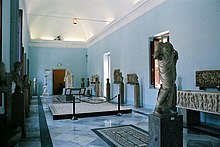Regional Archeological Museum Antonio Salinas
| Museo Archeologico Regionale Antonio Salinas | |

A room in the museum
|
|
| Location | Via Bara all'Olivella 24, Palermo, Italy |
|---|---|
| Coordinates | 38°07′15″N 13°21′38″E / 38.12083°N 13.36056°ECoordinates: 38°07′15″N 13°21′38″E / 38.12083°N 13.36056°E |
| Website | www |
The Regional Archeological Museum Antonio Salinas (Italian: Museo Archeologico Regionale Antonio Salinas) is a museum in Palermo, Italy. It possesses one of the richest collections of Punic and Ancient Greek art in Italy, as well as many items related to the history of Sicily. Formerly the property of the Oratory of Saint Philip Neri, the museum is dedicated to Antonio Salinas, a famous archaeologist and numismatist from Palermo. It is part of the Olivella monumental complex, which includes the Church of St. Ignatius and the adjoining Oratory.
The construction of the Olivella complex was begun in the late sixteenth century by the architect Antonio Muttone for the Oratory of Saint Philip Neri and completed in the seventeenth century. Following the law on the suppression of religious orders of 1866 the building was confiscated and became home to the museum.
During the Second World War the director of the museum, Jole Bovio Marconi, moved all the material held in the museum to the monastery of San Martino delle Scale. This saved the collection from destruction by the bombing during the Allied invasion of Sicily. In 1949 Bovio Marconi was made responsible for the redevelopment of the museum, as the building was heavily damaged the building was renovated by architect William De Angelis D'Ossat. From 18 July 2011 the museum has been closed for renovation. As of September 2015, only a small part of the museum is accessible free of charge. It is uncertain when the full exhibition will be reopened.
On the ground floor, a section is dedicated to the artefacts found underwater, including materials that were part of the cargo of vessels, stone anchors, strains of lead, lamps, amphoras and inscriptions ranging from the culture of the Phoenicians to that of the Romans.
The Phoenician section displays two large anthropomorphic sarcophagi of the fifth century BC from the necropolis of Pizzo Cannita (near modern Misilmeri). There are also sculptures of gods and Phoenician votive stelae from Mozia and Lilybaeum.
...
Wikipedia

